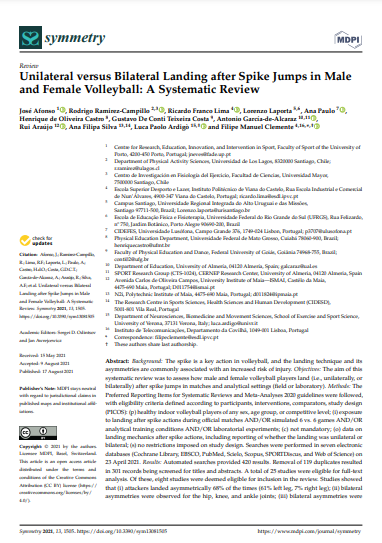Unilateral versus Bilateral Landing after Spike Jumps in Male and Female Volleyball: A Systematic Review

Fecha
2021-08-06Autor
Afonso, Jose
Lima, Ricardo Franco
Laporta, Lorenzo
Paulo, Ana
Castro, Henrique de Oliveira
Costa, Gustavo De Conti Teixeira
Garcia-de-Alcaraz, Antonio
Araujo, Rui
Silva, Ana Filipa
Ardigo, Luca Paolo
Clemente, Filipe Manuel
Ramirez-Campillo, Rodrigo [Univ Mayor, Fac Ciencias, Ctr Invest Fisiol Ejercicio, Chile]
Ubicación geográfica
Notas
HERRAMIENTAS
Acceda a títulos restringidos
¿Cómo descargar?Resumen
Background: The spike is a key action in volleyball, and the landing technique and its asymmetries are commonly associated with an increased risk of injury. Objectives: The aim of this systematic review was to assess how male and female volleyball players land (i.e., unilaterally, or bilaterally) after spike jumps in matches and analytical settings (field or laboratory). Methods: The Preferred Reporting Items for Systematic Reviews and Meta-Analyses 2020 guidelines were followed, with eligibility criteria defined according to participants, interventions, comparators, study design (PICOS): (p) healthy indoor volleyball players of any sex, age group, or competitive level; (i) exposure to landing after spike actions during official matches AND/OR simulated 6 vs. 6 games AND/OR analytical training conditions AND/OR laboratorial experiments; (c) not mandatory; (o) data on landing mechanics after spike actions, including reporting of whether the landing was unilateral or bilateral; (s) no restrictions imposed on study design. Searches were performed in seven electronic databases (Cochrane Library, EBSCO, PubMed, Scielo, Scopus, SPORTDiscus, and Web of Science) on 23 April 2021. Results: Automated searches provided 420 results. Removal of 119 duplicates resulted in 301 records being screened for titles and abstracts. A total of 25 studies were eligible for full-text analysis. Of these, eight studies were deemed eligible for inclusion in the review. Studies showed that (i) attackers landed asymmetrically 68% of the times (61% left leg, 7% right leg); (ii) bilateral asymmetries were observed for the hip, knee, and ankle joints; (iii) bilateral asymmetries were observed even when players were instructed to land evenly on two feet; (iv) landing contact of the leg opposite to the hitting arm preceded the contact of the homolateral leg. One match analysis study showed that men landed more often on the left (31.5%) or right foot (8.5%) than women (23.7% and 1.6%). Conclusions: Studies analyzing spike landing showed a prevalence of unilateral landings (mostly the left leg first, for right-handed players) in men and women but more prevalently in men. Registration INPLASY202140104, DOI: 10.37766/inplasy2021.4.0104.
URI
https://repositorio.umayor.cl/xmlui/handle/sibum/9044https://doi.org/10.3390/sym13081505
https://www.mdpi.com/2073-8994/13/8/1505/pdf?version=1629777777
https://recil.ensinolusofona.pt/bitstream/10437/12174/1/symmetry-13-01505-v2.pdf
https://repositorio.ual.es/bitstream/handle/10835/12087/symmetry-13-01505-v2.pdf;jsessionid=B9FE04F8E397B2A01D9FD0A1F943E9C8?sequence=1
Coleccion/es a la/s que pertenece:
Si usted es autor(a) de este documento y NO desea que su publicación tenga acceso público en este repositorio, por favor complete el formulario aquí.